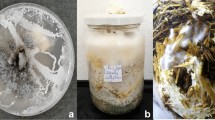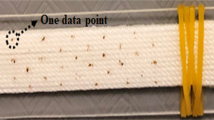Abstract
The production of a homogeneous liquid culture of mushroom mycelium with a high density of viable inoculum points is a prerequisite for the adaptation of the liquid culture technology to the mushroom spawn production process. Homogenisation proved unsuitable as a technique to produce a morphology of this nature because of the shear sensitive nature of Agaricus bisporus. To overcome this limitation, a homogeneous culture was produced by exposing culture flasks to alternating periods of shear stress (300 rpm on a shaker table for 60 min day−1) and recovery (23 h day−1 under static conditions).
Similar content being viewed by others
References
Eyal J (1991) Mushroom mycelium grown in submerged culture-Potential food applications. In: Goldberg I, Williams R, eds. Biotechnology and Food Ingredients. New York: Van Nostrand Reinhold, pp. 31-64.
Humfeld H (1948) The production of mushroom mycelium (Agaricus campestris) in submerged culture. Science 107: 373.
Itavaara M (1993) Problems associated with the liquid cultivation of shiitake Lentinula edodes (Berk.) Pegler. VTT Publications (Technical Research Centre of Finland) 150: 11-62.
Kawai G, Kobayashi H, Fukushima Y, Ohsaki K (1995) Effect of liquid mycelial culture used as a spawn on sawdust cultivation of shiitake (Lentinula edodes). Mycoscience 37: 201-207.
Leatham GF, Griffin TJ (1984) Adapting liquid spawn Lentinus edodes to oak wood. Appl. Microbiol. Biotechnol. 20: 360-363.
Parker DS, Kaufman WJ, Jenkins D (1971) Physical conditioning of activated sludge floc. J. Wat. Poll. Cont. Fed. 43: 1817-1833.
Rainey PB (1989) A new laboratory medium for the cultivation of Agaricus bisporus. New Zealand Nat. Sci. 16: 109-112.
Savage GM, Vander Brook MJ (1946) The fragmentation of the mycelium of Penicillium chrysogenum by a high speed blender and the evaluation of blended speed. J. Bacteriol. 52: 385-391.
Schugerl K, Wittler R, Lorenz T (1983) The use of molds in pellet form. Trends Biotechnol. 1: 120-123.
Song CH, Cho KY, Nair NG (1987) A synthetic media for the production of submerged cultures of Lentinus edodes. Mycology 79: 866-876.
Vasdev K, Kuhad RC (1994) Induction of laccase production in Cyathus bulleri under shaking and static culture conditions. Folia Microbiol. 39: 326-330.
Author information
Authors and Affiliations
Rights and permissions
About this article
Cite this article
Friel, M.T., McLoughlin, A.J. Production of a liquid inoculum/spawn of Agaricus bisporus. Biotechnology Letters 22, 351–354 (2000). https://doi.org/10.1023/A:1005616516646
Issue Date:
DOI: https://doi.org/10.1023/A:1005616516646




